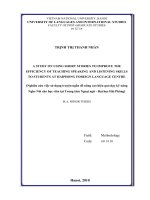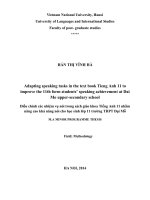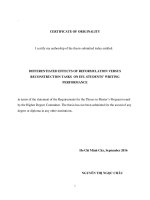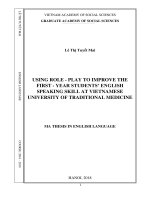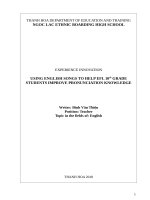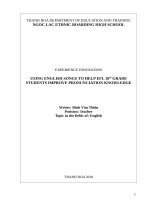USING MINIMAL RESPONSES TO IMPROVE EFL HIGH SCHOOL STUDENTS’ SPEAKING ABILITY
Bạn đang xem bản rút gọn của tài liệu. Xem và tải ngay bản đầy đủ của tài liệu tại đây (451.49 KB, 126 trang )
MINISTRY OF EDUCATION AND TRAINING
VINH UNIVERSITY
TRAN THI NGAN
USING MINIMAL RESPONSES TO IMPROVE EFL HIGH SCHOOL
STUDENTS’ SPEAKING ABILITY
MASTER’S THESIS IN EDUCATION
Nghe An, 2017
J
1
MINISTRY OF EDUCATION AND TRAINING
VINH UNIVERSITY
Major: Teaching English to Speakers of Other Languages (TESOL)
Code: 60140111
MASTER’S THESIS IN EDUCATION
Supervisor: Dr. Tran Thi Ngoc Yen
Nghe An, 2017
[ Ì1
if
First of all, I would like to express my deep gratitude to Dr. Tran Thi Ngoc
Yen, who directly supported and encouraged me during the preparation of this
study. I am truly grateful to her for her professional advice, invaluable support and
guidance she offered to help me carry out the study.
I would also like to thank to the students of the two classes I worked with in
order to gather data for my study.
I am also indebted to my friends for proofreading the first draft of the thesis.
Last but not least, I would like to express my special heartfelt appreciation to
my parents without whose unceasing support, patience and understanding I
could not have been able to complete my study.
ABSTRACT
The main goal in this study is to find out if using minimal responses has any
effect on EFL learners’ speaking ability. In order to achieve the mentioned goal, a
study was carried out among forty 10th graders 10 at a high school in Ha Tinh
province. The participants were divided into two groups, each of which had 20
students. One served the control group and the other treatment group. Before the
treatment, all participants did a general English test. Then both groups were asked
to sit the pre-test before participating in the speaking sessions. A post-test was
administered after the treatment to measure the participant’s speaking fluency and
accuracy. The collected data were analyzed in terms of fluency (number of words
per minute) and accuracy (number of errors per 100 words). The data indicated that
the students’ speaking fluency and accuracy improved to a great extent than that of
the control group. Based on the findings, some implications for teaching English
speaking were proposed. Limitations of the study were also pointed out and further
research was suggested.
Page
Table 4.14 Means and standard deviations of error in the first session and
the last
This chapter consists of the following five parts which offer a general outline
of the study: rationale, the aims and objectives, research questions, scopes and
design of the study.
1.1 Rationale
Nowadays, the tendency of globalization has brought about a great demand of
intercommunicating. In order to meet this demand, English has become an
international language for global communication and a compulsory subject at
schools. As a result, in Vietnam, in recently years, English has been most widely
taught from primary schools to universities in both private enterprises and state
offices. In addition, it has become even more important because the students have to
take English exams. Therefore, they are required to acquire various skills and
language items. In the light of Communicative Language Teaching (CLT), students
are required not only to have a good grammatical competence, but also welldeveloped language skills, especially for speaking skill. In any second language
teaching and learning, speaking is always believed to be the most vital skill.
Consequently, improving speaking skill is very important and necessary to students,
even for their exams. This will help them to have a good job in their future and
enable them to communicate with foreigners successfully.
However, teaching and learning English in general and teaching and learning
speaking in particular does not come up to the study aims. Although at many high
schools all the teachers have been trying their best to provide language learners with
opportunities to develop their communicative skills, they cannot speak English
fluently and accurately. It is mostly seen that in Vietnam learners still lack
confidence in their ability to participate successfully in oral interaction.
After five years teaching, I see that most of my students cannot speak English
fluently and accurately in a meaningful way. They have a lot of problems during
speaking skill periods or oral tests. The students are afraid of speaking or they
do not want to express their ideas, and they often listen in silence while others
do the
talking. The teachers find it difficult to motivate students. This condition demands
teachers to find the best way to improve students’ language speaking ability. With a
good speaking skill, he or she is able to show his or her ideas more easily. Leaners
can communicate naturally. Therefore, the author has decided to conduct the study
entitled “ Using minimal responses to improve EFL high school students'
speaking ability” with the hope teachers to help their learners get out of the always
silent moment in class, and thereby, improve their speaking ability.
1.2 Aims of the study
The study was conducted with the aims to investigate the effect of minimal
responses.
1.3 Research questions
This research was set out to seek the following questions:
1. How does the use of minimal responses affect EFL high school students’ speaking
accuracy?
2. How does the use of minimal responses affect EFL high school students’ speaking
fluency?
1.4 Scope of study
This study limits itself to investigating the use of minimal responses in
improving EFL students’ speaking ability at a moutainous high school in Ha Tinh.
It dealt with the use of minimal responses to improve EFL high school
students’ speaking accuracy and fluency.
1.5 Organization of the thesis
The thesis is consisted of five chapters.
Chapter 1: The Introduction is a brief overview of the study with more details
of rationale, aims, research questions, scope of study as well as design of the study.
Chapter 2: Literature review. This chapter presents the theoretical background
of the research which contains four main issues: speaking ability, assessing
speaking ability, teaching speaking to EFL learners and minimal responses in
language teaching
Chapter 3: Methodology. In this chapter, the focus will be on background
information of the subject of the study, the instruments used to collect data and the
procedure of data collection.
Chapter 4: Findings and discussion. This chapter presents a description of data
analysis and discussions.
Chapter 5: Conclusion. The focus is devoted to the summary of the findings
and some suggested pedagogical recommendations to help teachers and students in
upper secondary schools to overcome difficulties in learning and teaching English
pronunciation. This chapter also provides the limitations of the study as well as
some recommendations for further study.
2.1 Speaking ability
It discusses the definition of speaking, the nature of speaking, the function of
speaking, the aspect of speaking ability, and macro and micro skill of speaking
ability.
2.1.1
Definition
It has long been recognized that speaking skill is very important in learning a
language, since the success of using a language especially second and foreign
language in real life situation can be measured through speaking. For example,
someone can be told that he or she is capable of speaking English if he or she is
able to show his or her English by practicing it through speaking. Finochiaro in
Sukrianto (1974, p. 22) claimed that speaking is a real language, which means that
the capability to communicate in a language that can be shown through the skill of
speaking. The skill of speaking refers to the students’ ability to express mind or
feeling orally. One function of speaking is to communicate ideas in situation where
the other person is listening to words and can be in front of the speaker, looking at
the gesture and facial expression. In other words, we can say that speaking is the
skill or capability to deliver messages directly.
Clark and Clark in Goga (2004, p. 27) stated that speaking is fundamentally an
instrument of act. Speakers talk in order to have some effect on their listeners. They
assert things to change their state of knowledge. They ask them questions to get
them to provide information. They request thing to get them to do thing for them.
Speaking is an interactive process of constructing meaning that involves
producing and receiving and processing information (Burn and Joyce, 1997, p. 63).
Its form and meaning are dependent on the context in which it occurs, including the
participants themselves, their collective experiences, the physical environment, and
the purposes of speaking.
Widdowson (1985, p. 58) states that an act of communication through speaking
is commonly performed in face to face interaction and occurs as a part of
dialogue or rather from verbal exchange. Another basic distinction we can make
when considering of speaking skill is between monologue and dialogue or pair
work. The ability to give an uninterrupted oral presentation is quite distinct from
interacting with one or more other speakers for transactional and interaction
purposes. While all native speakers can use language interaction, not all native
speakers have the ability to extemporize on given subject to a group of listeners.
This ability is generally has to be learned and practiced.
The descriptions of speaking above made the writer concluded that speaking is
the ability to use of language in ordinary way of speech. It is not only matter of
transferring some massages to another but also is communication which needs more
than one person to communicate with.
2.1.2
Functions of speaking
Brown and Yule in Fauzi (2012, p. 4) also describe a useful distinction
between two basic language function. These are the transactional function, which is
primarily concerned with the transfer of information, and the interactional function,
in which the primary purpose of speech is the maintenance of social relationship.
Another basic distinction when considering the development of speaking
ability is between monologue and dialogue. The ability to give an uninterrupted oral
presentation is very clear from interacting one people and another speakers for
transactional and intersectional purpose, while, all native speakers can and do use
language interaction, not all native speaker have the ability to be extempore on a
given subject to group of listeners. Furthermore, Brown and Yule in Fauzi (2012, p.
4) suggest that most language teaching is concerned with developing skills in short
intersectional exchanges in which the learner is only required to make one or two
utterance at a time.
Based on the above statement, Bygate in Fauzi (2012, p. 5) distinguishes that
“between motor-perceptive skill, which are concerned with correctly using the
sound and structures of language, and interactional skill, which involves motor
perceptive skill for the purpose of communication” motor perceptive skill are
developed in the language classroom through activities such as model dialogues,
patterns practice, oral drills and so on, until relatively recently, it was assumed that
the mastery of motor perceptive skill was that needed all one, in order to
communicated successfully.
2.1.3
The nature of speaking ability
Brown (in Islamiyah, 2007, p. 14) states that speaking is a productive skill that
can be directly and empirically observed, those observations are invariably collared
by the accuracy and fluency. He also states that speaking is the product of creative
construction of linguistic strings, the speakers make choices of lexicon, structure,
and discourse.
Poerdarminta (Islamiyah, 2007, p. 14) states that the classical meaning of
speaking is the ability to talk, and to speak. The main purpose of speaking is to send
the message for the other one or to be able to communicate about something in
language and understood by someone who becomes a listener.
Tarigan (Islamiyah, 2007, p. 14) states that speaking is one of the language
skills in oral form to express the speakers’ ideas to everybody else. While, speaking
is the informal interchange of thought and information by spoken words.
2.1.4
Micro and macro skill of speaking ability
Micro skill of speaking. Here are some of the micro skills involved in
speaking. The speaker has to pronounce the distinctive sounds of a language clearly
enough so that people can distinguish them. This includes making tonal distinctions.
Use stress and rhythmic patterns, and intonation patterns of the language clearly
enough so that people can understand what is said. Use the correct forms of words.
This may mean, for example, changes in the tense, case or gender. Put words
together in correct word order and use vocabulary appropriately. Use the register or
language variety that is appropriate to the situation and the relationship to the
conversation partner. Make clear to the listener the main sentence constituents, such
as subject, verb, object, by whatever means the language uses. Make the main ideas
stand out from supporting ideas or information. Make the discourse hang together so
that people can follow what you are saying (Carol Orwig 1999, p. 23).
Macro Skills of Speaking (Sharma, 2010, p. 5). Here are the skills that should
be implemented in speaking activities: appropriately accomplish communicative
functions according to situations, participants, and goals. Use appropriate styles,
registers, implicative, redundancies, pragmatic conventions, conversion rules, floor
keeping and yielding, interrupting, and other sociolinguistic features in face-to-face
conversations. Convey links and connections between events and communicate
such relations as focal and peripheral ideas, events and feeling, new information
and given information, generalisation and exemplification. Convey facial features,
kinesics, body language, and other nonverbal cues along with verbal language.
Develop and use a battery of speaking strategies, such as emphasizing key words,
rephrasing, providing a context for interpreting the meaning of words, appealing for
help, and accurately assessing how well your interlocutor is understanding you.
2.1.5
The aspects of speaking ability
Darmodihardjo in Fauzi (2012, p. 7) states that is “the requirements of
effective speaking” are: intonation, phonetic transcription and environment
expression. The opinion describes that, to able communicate effectively, it must be
considered that situation of sound utterance, pronunciation and physical. On the
other hand, Valetto in Fauzi (2012, p. 7) says that “The elements which are in
speaking cover phonetic transcription, grammar, vocabulary, the effective and
speaking”
Meanwhile, Haris in Fauzi (2012, p. 7) clarifies as follows: “Like writing
speaking is complex skill requiring the simultaneous use of number of the different
abilities which often developed of different rates either four of five components are
generally recognized in analyze of the speak process: (a) pronunciation concluding
the segmental features vowel, and consonants, vocabulary, stress and intonation
pattern the flow speech, (b) grammar, (c) vocabulary, (d) fluency (the case and
speed of the flow speech). The solve probably be added, (e) comprehension for oral
communication certainly requires a subject the response to speak as well as
imitation ”.
2.2 Assessing speaking ability
Testing oral proficiency has become one of the most important issues in
language testing since the role of speaking ability has become more central in
language teaching (Hartley & Sporing, 1999). There are three characteristics that
distinguish performance assessments from other types of tests. They are focused
mainly on content. However, testing speaking is difficult and cannot be assessed as
precisely and without difficulty as other language skills. It takes considerable time,
effort and training (Hughes, 2003). Despite the difficulty of evaluating speaking
tests, they should be designed, and administered regardless of how costly they
might be.
Freed (1995) and Fulcher (1996) refer to how fluent the speaker is can be used
in a range of senses. One of the narrowest definitions include a few features, such as
pausing, hesitations and speech production rate, whereas in a broad sense the
reference is made to speaking proficiency. Unless the term is defined explicitly, it is
simply not clear what a speaker or writer means by it. Definitions of fluency often
include references to flow or smoothness, rate of speech, lack of unnecessary
pausing, absence of distressing hesitation, length of utterances, and connectedness
(Koponen, 1995). These characterizations are complex, however, because they are
not simply descriptions of a speaker’s speech but also of a listener’s perception of it.
One central part of fluency is related to temporal aspects of speech, such as
speaking rate, speech-pause relationships, and frequency. Both kinds of studies
indicate that when speakers become more fluent their speech rate increases and the
speech flow contains fewer pauses and hesitations (Lennon, 1990; Freed, 1995).
They also pause at semantically sensible places, which listeners perceive as the
speakers’ planning the content of what they are saying rather than groping for
words. More fluent speakers tend to speak more and their phrases are longer.
(Luoma, 2004). In addition to time-bound speed and pausing phenomena,
fluency is related to the way that speakers use words, and in particular ‘small
words’ such as really, I mean, and oh (Hasselgren, 1998). To focus on the more
lexical aspects of fluency, Hasselgren (1998) defined it as ‘the ability to contribute
to what a listener, proficient in the language, would normally perceive as coherent
speech, which can be understood without undue strain, and is carried out at a
comfortable pace, not being disjointed or disrupted by excessive hesitation. She
suggested that small words are significant in this because they help speakers
produce relevant turns and understand the relevance of other speakers’
contributions. She has a summary of the tasks of small words that they express the
communicative intention of the speaker, with respect to what is to be communicated
and how it affects the interactional roles of the participants. They point to the
textual context in which an utterance has relevance. They indicate the cognitive
effect of the previous utterance. They enrich the explicature of an utterance, notably
by indicating degree of commitment and vagueness. They also indicate the state of
success of the communication, acknowledging this, or appealing for confirmation,
or assistance in bringing it about.
2.2.1
Indicators of speaking ability
Brown (2004, p. 141-142) indicating that one can be called have speaking
competence if he/she is able to imitate a word or phrase or possibly a sentence
(imitative), produce short stretches of oral language design to demonstrate
competence in a narrow band of grammatical, phrasal, lexical, or phonological
relationship. Such as prosodic elements-intonation, stress, rhythm, juncture,
intensive ability (intensive). He or she responds a very short conversation, standard
greetings and small talk, simple requests and comments, and the like (responsive) or
takes the two forms of either transactional language which has the purpose of
exchanging specific information, or interpersonal exchanges which have the
purpose of maintaining social relationships (interactive). Maintain social
relationships with the transmission of facts and information (interpersonal).
Develop (monologue) oral production including speeches, oral presentations, and
story-telling, during which the opportunity for oral interaction from listener is either
highly limited or ruled out together (extensive).
Meanwhile, Ur says (1999, p. 120) that the characteristics of a successful
speaking activity are as follows: Learners talk a lot, as much as possible of the
period of time allotted to the activity is in fact occupied by learners’ talk. This may
seem obvious, but oven most time is taken up with teacher talk or pauses.
Participation is even, Classroom discussion is not determined by a minority of talk
active participants; all get chance to speak, and contributions are fairly evenly
distributed. Motivation is high, learners are eager to speak; because they are
interested in the topic and have something new to say about it or because they want
to contribute to achieving a task objective. Language is of an acceptable level.
Learners express themselves in utterances that are relevant, easily comprehensible
to each other, and of an acceptable level of language accuracy.
2.2.2
Fluency, accuracy and complexity
Fluency in speaking does not lie totally only on accuracy as mastering the
language system but it also lays on the fluency as using the language system
communicatively, and without too much hesitation.
Richard and Rodgers (2001, p. 90) stated that fluency is the ability to produce
written or spoken language easily. This indicates that spoken language is produced
naturally with hurtles. They also added fluency is the ability to speak with a good
but not necessarily perfect command of intonation, vocabulary and grammar.
Meanwhile, Simon and Schuster in Amin (2006, p. 22) defined fluency as: (1) the
quality of flowing, smoothness, freedom from harshness, (2) the ability to write or
to speak easily, smoothly, expressively, readiness or smoothness of speech.
It can, therefore, be said that fluency is the ability to produce communicative
language even though it is not in perfect utterances but in continuous speech and
smooth. It asks students to perform it naturally as long as understandable and
communicable. Fluency is the ability to speak in an easy smooth manner. Fluency is
also as an aspect to be assessed by the researcher because of this aspect as one of
aspects that can indicate the students speaking ability.
Accuracy in speaking means when someone can produce correct sentences in
pronunciation, grammar and word choice so it can be understood. There are three
components of accuracy. They are pronunciation, vocabulary and grammar,
pronunciation. According to Alexander et al. (1998, p. 830) pronunciation is the
way in which a language or a word particular is pronounced. Teaching
pronunciation deals with recognition or understanding the flow of speech and
production of words. Teaching pronunciation is intended students can produce
speech which is intelligible in the areas where they use it. When a teacher teaches
English, he makes sure that the students’ utterances can be understood. They need to
be able to say what they want to say. This means that students’ pronunciation should
be at least adequate for the purpose. It is obviously, sending message orally without
acceptable and good pronunciation is impossible. Certainly, pronunciation can not
be separated from intonation and stress. Pronunciation, intonation and stress are
largely learnt successfully by imitating and repetition. Therefore, the teacher should
have good standard of pronunciation in order that the students can imitate the
teacher in teaching and learning process.
Language used by humans thereby must present some characteristics that
make it so unique and different from the way animals communicate. Yule’s work
(2006, p. 9 - 12) outlines the six crucial attributes of human language. The first
feature presented by the author is displacement. This trait allows users of a language
to discuss events, people and things not present in the immediate environment. The
second property is arbitrariness, which informs people that a relationship between a
linguistic form and its meaning does not exist - it is entirely arbitrary. For example,
deducing the meaning of a word wardrobe from only the form would be difficult for
a novice of a second language learner. There are some onomatopoeic words that
seem to mirror the sounds they stand for, but they are relatively occasional. The
next feature, productivity, informs us that the possibility to produce the potential
number of utterances in any human language is infinite. Children are able to create
new sentences they have hitherto never heard. What is more, people who find
themselves in new situations can describe the new position, whilst animals cannot.
The fourth characteristic of human language is discreteness, which points out the
distinctions among sounds of a language are significant. To illustrate this
phenomenon, the apparently small difference between the /p/ and /b/ sounds is
meaningful when used in words like pig and big. The last but one quality of human
language is duality. This property notifies that people’s language is organized at two
levels. At one level, we are able to produce separate discrete sounds, like /i/, /p/
and /n/. At another, the mentioned sounds may be arranged into “nip”, but also into
“pin”. Finally, cultural transmission informs us that while physical features such as
face shape or the eye color may be inherited, a language cannot. Children are born
with an innate capacity to acquire language, but they do not have a genetic
predisposition to acquire a specific one.
At this point, another significant question should be explained, namely: what
does it actually mean to know a language? Yule (2006, p. 169) defines it as “[t]he
general ability to use language accurately, appropriately and flexibly as
communicative competence”
The first component of this definition emphasizes the accuracy of producing
and understanding words and structures, which Yule then names as grammatical
competence. The only concentration on that competence will surely not provide a
student with the ability both to provide and produce L2 precisely, and for that
reason other elements of communicative competence must be distinguished.
According to Tarone and Yule (1989, p. 18), “[s]ocio linguistic competence allows
the language user to select which utterance form, from any number of possible
correct forms, is considered appropriate within a language community on a
particular interactive occasion.” It means that students must learn which structures
are appropriate to the situations they are in and the people they are talking to. The
last part of the entry from the beginning of the paragraph pertains to strategic
competence that is connected with the ability to utilise communication strategies to
cope with difficulties which arise in the course of getting man’s message across to a
particular listener. For example, a woman may know a target deal about the
grammatical structure of German as a second language, and yet be unable to use the
language to get herself from the airport to the hotel in Germany. In view of what an
intended and actual act of speech looks like, Fromkin, Rodman and Hyamas (2003,
p. 9) define the knowledge of a language a person knows as linguistic competence,
whereas the procedure of how people exploit that knowledge in real speech
production and comprehension is defined as linguistic performance. What a speaker
actually says is influenced by non-linguistic features like hesitation or stress, which
may result in making grammatical mistakes. The way a student utters sounds during
a foreign language lesson is very often influenced by these factors, thus, what was
planned to say, unfortunately differs from the actual speech.
Still, in the issue of communicative competence, the work of Harmer (2001, p.
269-271) clarifies that if a person is able to speak a language it means that the
speaker possesses the knowledge of the target language’s features, and he or she has
the ability to process information on the spot. The author indicates that language’s
features make reference to linguistic competence and comprise the following
elements: connected speech, expressive devices, lexis and grammar, and negotiation
language. Students should be aware that natural processes like omitting words or
weakening sounds occur in real-life situations during speeches. Activities which
practise connected speech, rather than activities focused only on individual
phonemes, improve learners" fluency.
It is also advisable to try to implement certain supra segmental features in
order to show emotions and attitudes, for instance by varying the speed of utterance
or changing facial expressions. Students also need to know various phrases and
conversational patterns since negotiation language involves expressions people
often use for clarifications, such as “could you explain it to me one more time,
please? ”
Next, the author adds that not only are the above-mentioned language’s
features necessary to succeed in speaking process but “[s]success is also dependent
upon the rapid processing skills that talking necessitates” (Harmer 2001, p. 271).
These skills are: language processing, interacting with others and (on-the-spot)
information processing. Language processing allows retrieving the words and
phrases that are stored in one’s memory and then arranging them in syntactically
correct sentences. Secondly, effective speaking also requires a good deal of
listening to and understanding other participants" feelings, as well as cultural and
social rules such as turn-taking or how loud to speak. Finally, the pace of processing
the World Scientific News 7 (2015) information plays an important role - the faster
a speaker is able to respond, the more efficient communication is.
Beyond question, linguistic knowledge about the notion of communication
and then about a language is very important when investigating teaching speaking a
foreign language. The areas of communicative competence attempt to explain what
knowledge about a target language a learner should possess.
2.2.3
Rubrics for assessing speaking ability
Assessing speaking is not something easy to do because there are some factors
that may influence the teacher’s impression on giving score. Speaking is a complex
skill requiring the simultaneous use of different ability which often develops at
different roles. The score of speaking may be different from one teacher to others.
For example in assigning a score ranging from 1 to 5 is not something simple to do
because the line of distinction between levels are quite difficult to pinpoint. To
overcome that problem which the students have, the teacher needs to assign several
scores for each response, and each score representing one of several traits like
pronunciation, grammar, vocabulary use, fluency, and comprehensibility (Brown,
2004, P. 140)
The students’ speaking performances were assessed using a scoring rubric
proposed by David P. Harris as it is cited in Nurnia (2011, p. 27). The rubric is
shown in the following table.
No
Language
Score
Description
Elements
9
Able to speak without any hesitation or break in a
sentence
8
1
Fluency
7
6
5
2
Grammatical
Accuracy
Hesitates or pauses at a few places in a few sentences
but fluency is not seriously affected
Hesitation is shown
Almost every sentences contains grammar error
A lot of grammatical errors are made that meaning of
9
messages is not clear
Grammar is correct
8
7
A few grammatical errors. Meaning is not affected
One or two major errors which affect the meaning
6
5
Almost every sentence contains grammatical error
9
8
A lot of grammatical errors are made that meaning of
messages is not clear
All words are clearly and correctly pronounced
One of two words are incorrectly pronounced but
meaning is not affected
7
3
Pronunciation
meaning is not affected
6
4
Vocabulary
A few words are are incorrectly pronounced but
One or two words which are mispronounced cause
5
meaning to be affected
Most of the words are correctly pronounced
9
Use extensive vocabulary
8
7
Use various vocabulary
Use adequate vocabulary, some words usage
irregularities
6
5
Use limited vocabulary
Use not understandable vocabulary
From the scoring rubric of speaking, the computation of the students’ score used the
following formula:
The students’ speaking score = the score obtained : 4( language elements)
Using the computation, the students’ score ranged from 5 to 9. The teacher organized
the students’ score into five categories.
Grade 5 to 5.9 : poor speaking
Grade 6 to 6.9 : fair speaking
Grade 7 to 7.9 : good speaking
Grade 8 to 8.9 : very good speaking
Grade 9: excellent speaking
2.2.4
Methods to assess speaking ability
According to categorizations of Underhill’s (1987) oral language testing
methods and Luoma’s (2004) speaking task types, with an emphasis on Underhill’s
work where the different testing methods were discussed in greater detail and more
comprehensively. Luoma categorizes the tasks into three groups of open-ended,
semi-structured and structured speaking task types, differing somewhat from the
lists Underhill provides. Bachman (1990, p. 77) states that with the great number of
different testing methods it is impossible to compile a comprehensive list of all the
methods used. As Underhill (1987, p. 44) reveals there are over sixty methods with
which to test oral skills. According to Weir (1990, p. 42) test methods are used to
formulate tests but they are not in themselves tests. He continues that it is possible
to talk about a good test or a bad test, or a valid or invalid test, but this is not
possible for methods. For instance, using a multiple-choice procedure might
produce a valid test in one context but not in another.
Some of the most often used techniques are summarized here and, as
mentioned above, they are grouped into the three categories of direct, semi-direct
and indirect methods. It has to be noted here however that for instance Bachman
(1990, p. 77) does not consider certain methods listed here, such as sentence
completion and multiple choice, as “methods” at all but rather as combinations of
various features of task types, instructions and types of input. What is more, as
stated before, according to Weir (1990, p. 42) different methods are used to
construct tests but they are not in themselves tests. There are indeed different
interpretations of testing methods.
To begin with, the so-called direct methods, or open-ended speaking tasks,
(Luoma, 2004, p. 48), measure speaking skills directly and the test situation
resembles a real-life communication situation (Underhill, 1987, p. 44 - 45). Luoma
claims that even though the open-ended speaking tasks direct the discussion, they
allow the test takers a certain freedom to utilize their cognitive skills in performing
the tasks.
One of the direct methods is discussion/conversation, which of course
encourages the learner into a communicative approach. Indeed, conversation is
perhaps the most natural way for two people to communicate. The interviewer gives
the learner a chance to speak his mind but at the same time has an important role as
a perceptive person leading the conversation. Additionally, the interviewer’s job is
to generate an appropriate atmosphere for a successful dialogue to take place. When
considering different types of personalities a disadvantage of this testing technique
may be that a shy learner might feel underprivileged compared to an outgoing
colearner (McNamara, 2000, p. 82). Indeed, a successful conversation method in
testing oral skills requires the learners’ willingness to propose new topics for
discussion, ask questions, and articulate disagreement when they are aware they are
being evaluated. As Underhill (1987, p. 44 - 45) states, the learners need to be ready
to take certain risks in the communication. The conversation can also take place in
